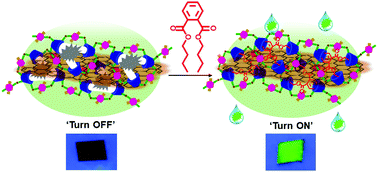Selective capturing and fluorescence “turn on” detection of dibutyl phthalate using a molecular imprinted nanocomposite†
Abstract
Dibutyl phthalate is a potential endocrine-disrupting chemical, and its detection in the environment/water at trace levels is a critical issue to avoid its consumption by humans. However, the selective detection of dibutyl phthalate via a simple and cost-effective approach is challenging. Here, we report the fluorescence-based selective detection of dibutyl phthalate at micromolar concentration without using any antibodies. We have designed a nanocomposite made of graphene oxide and poly-cyclodextrin with the molecular imprint of dibutyl phthalate. The molecular imprint inside the nanocomposite offers selective capture of dibutyl phthalate, and graphene oxide offers fluorescence “turn on” detection via a competitive binding interaction with fluorescein. A nanocomposite-incorporating a paper strip is developed for the simple read out detection of dibutyl phthalate in contaminated water. The developed method can be used for the selective detection of dibutyl phthalate in water, and the approach can be extended for the detection/separation of other environmental pollutants.



 Please wait while we load your content...
Please wait while we load your content...